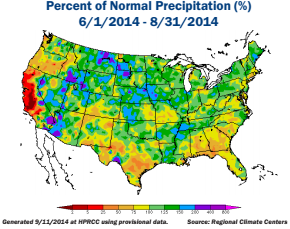B. Pollination and Grain-Fill Conditions – Summer (June – August)
Wet June, cool June and July favored pollination and starch accumulation, but delayed maturity
Corn pollination typically occurs in July, and at pollination time, greater than average temperatures or lack of rain typically reduce the number of kernels. The weather conditions during the grain-filling period in July and August are critical to determining final grain composition. During this time, moderate rainfall and cooler than average temperatures, especially overnight temperatures, promote starch and oil accumulation and increased yields. Moderate rainfall and warm temperatures in the second half of grain-fill (August to September) also aid continued nitrogen uptake and photosynthesis. Nitrogen also remobilizes from the leaves to the grain during grain-filling, leading to increases in grain protein and density.
In June 2014, abundant rainfall throughout the corngrowing regions flooded fields, and removed some of the nitrogen fertilizer from the soil before the plant could accumulate it, thereby reducing the final grain protein concentration. However, the rain in June helped to minimize the multi-year drought conditions in the Southern Rail ECA.
In July of 2014, there was excellent pollination, primarily due to cool, sunny conditions in the Pacific Northwest and Gulf ECAs. In addition, ample soil moisture favored second ears in some fields. Late July saw the return of major storms. This wet weather from late pollination time into August may have encouraged Diplodia and Gibberella ear rots in some areas. Additionally, cool temperatures and ample rain promoted photosynthesis, longer ears, and greater than average starch concentration. Unfortunately, the ample rains may have removed some of the nitrogen fertilizer in 2014, preventing maximum uptake and grain protein concentration.
In the Southern Rail ECA, the weather was abnormally dry and cold in July, but residual moisture from June helped plant growth. The cool weather probably prevented Aspergillus mold formation, which prefers hot and dry conditions after pollination. During grain-fill, the weather warmed up above average, but continued with dry conditions, and led to greater than average starch and decreased protein concentration.
